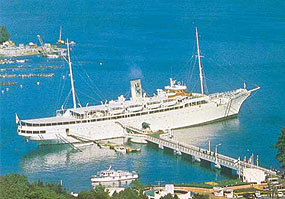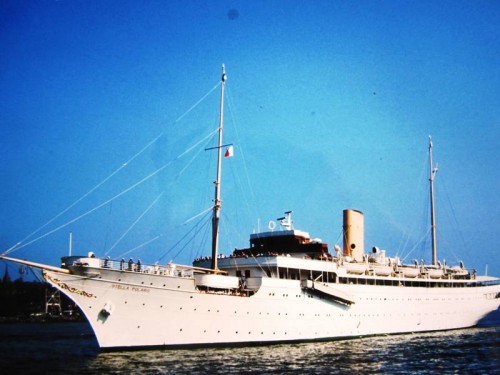Although the focus of passenger shipping was still on liner services, the North Atlantic run being the most famous one, slowly some shipping lines were considering entering the world of cruising. One of them was the Bergenske Dampskipsselskap, or Bergen Line, of Norway. The contract for their newbuilding was won by the Swedish yards of Götaverken in Göteborg, and on August 4,1925 the contract was signed.
Her building price was 4 million Swedish Krone, at the time a large sum of money. Her yacht-like appearance, exclusive interior fittings as well as the extensive use of electricity on board for hotel operations, a novelty at the time, made her an outstanding vessel, and she was in fact one of the first purpose-built, full-time cruise ships.
Stella Polaris interiors were arranged as was customary in the years of the exclusive luxury steam-yacht.


Stella Polaris‘ interiors were nothing short of splendid.
There were 6 passenger decks, Promenade Deck and Decks A to E. On Promenade- and A Decks, the main lounge/ music salon, 2 small writing rooms, smoking room, vestibules and the dining room seating max. 214 guests, meaning all passengers could be served in one seating, were situated. The dining room was the most spacious room on board, on its ceiling 150 lamps formed a star. Aft on Promenade Deck, the only deck having just public spaces, another entrance foyer and a small verandah cafe were located.
Passenger cabins were to be found on the remaining decks. Her most luxuriously appointed accommodations were 4 suites (on C Deck), each fitted with its own sort of wood: mahogany, maple, pear and birch respectively.
The general lay-out of the Stella Polaris and the interior-decorating and furnishing all followed the main purpose of creating a ship for a very limited number of wealthy passengers with an atmosphere of spaciousness, both in her interiors as well as on the open decks.
Most of the passenger-accomodation was situated aft in the vessel: four deluxe suites with separate sitting-room and bed-room, twelve luxury smaller suites and the remainder were standard cabins of wihich fifty-one were suited for single use. Bathrooms for these lower-grade staterooms were provided in the center of the ship, for each two/ three cabins a bathroom was available.


Luxury accommodations aboard Stella Polaris: sitting-room and bed-room in her grande suites
Stella Polaris was the most famous cruise ship of the thirties, the inter war years and some think probably even in the history of cruising.
She was owned by Bergen Line from Norway during the first part of her career, and resembled a royal yacht, with her clipper bow, bowsprit, well deck, open bridge, teak decking and lavish accommodations for just 200 passengers. Her white hull, yellow funnel and two masts gave her a classic appearance. Being built by Gotaverken in Goteborg in 1925-26, she measured 5.020 GRT and went into service in early 1927.
As mentioned, Bergen Line ordered Stella Polaris in Sweden; it was the first passenger vessel built by Gotaverken. They built the hull, and interior fittings were subcontracted to other firms. For example Selander & Sons produced and fitted all the gorgeous but very expensive woodwork on board.
She was launched in September 1926 by miss Lehmkuhl, the daughter of Bergen Line`s director. Sending her on trials in February 1927 already, these were so successful that the yard had no problems at all to deliver her on schedule. Instead of April 1st 1927, she was delivered 5 weeks early on February 26th.

Stella Polaris is considered one of the first “real” cruise ships in the history of cruising, being not only one of the first full-time cruise ships, but also one of the first purpose built for the cruise trade. For the most part, until the 1950s passenger ships were a means of transportation, and consequently, most cruise ships were passenger liners that were sent off cruising in “weak” periods, e.g. winter on the North Atlantic when passenger numbers were low.
Normally, the Stella Polaris carried about 200 passengers, and only half this number on round the world cruises. With a crew numbering 130, one can imagine the impeccable service onboard. When not on a world cruise, she mostly sailed in European waters.
After her maiden voyage which strted February 26, 1927 from Goteborg, she followed the same yearly pattern: Scandinavia and the Baltic during the summer, the Canary Islands and the Mediterranean in the winter. However, Stella Polaris became famous for her annaual circumnavigation of the globe. She would sail out of New York in January, via Cuba and then through the Panama Canal into the Pacific Ocean. New Guinea, the Philippines, Indonesia and Singapore followed and she would then set sail to Ceylon and India before rounding the Cape of Good Hope entering the final stretch of her world cruise leading her via Freetown, Las Palmas, Casablanca, Tangiers and Gibraltar to her final destination, Harwich.

Moored in Japan as a hotel – restaurant
She earned a loyal following over the years. A couple of Caribbean cruises did not sell well, so they were not repeated.
On June 11, 1937, Stella Polaris‘ career almost came to a sudden end, when she collided with the Norwegian freighter Nobel which was carrying ammunition and dynamite. She was lucky, Nobel sank without her dangerous cargo exploding. It had been Nobel being reponsible for the faulty navigating, Stella Polaris was not to blame here. She was left with damage to her bow and a shortened bowsprit, which was kept this way afterwards, a lasting souvenir of the incident.
Then, in September 1939, World War I erupted. Stella Polaris was laid up, but the inevitable happened in October 1940 when she was seized by the Germans and was used as a recreation vessel for U-boat officers until 1943.
At the end of the war after she had been handed back by the Germans she sailed as a troop ship and ferried Russian prisonors of war to Murmansk. When returned in November 1945 to her owners Bergen Line, her once beautiful classic interiors had been almost completely destroyed by the Germans.
Bergen Line still saw potential in their beloved ship and sent her back to her builders Gotaverken, and an almost new ship was redelivered. In the process her bridge was enclosed and a new dance salon was added. It cost Bergen line more than her original building price in 1927! Fortunately, her machinery had been spared by the Germans and still was in great condition.
She sailed on cruise after cruise for Bergen Line, even several times stepping in serving the company’s North Sea ferry services, but since the late 1940’s she had been on the sales list.
In 1951 she was sold to Swedish Clipper Line of ship owner Einar Hansen. She retained her name, but was immediately sent to Gotaverken again for a refit during which she received new carpeting and airconditioning in her public rooms.
Two years later, another refit took place, but this time work was carried out by AG Weser in Bremen. Her passenger capacity was now a mere 155 and her public areas were completely rebuilt. Most of her cabins now had private facilities.
Stella Polaris sailed for Clipper Line until 1969, mainly in European and Caribbean waters. She did not make world cruises anymore. Stella Polaris was refitted several times during this period, in 1965 and 1968, which saw her number of cabins reduced to around 70 as well as her number of crew members to about a hundred.
Because of her age (over 40 now), a new ship was needed as Stella Polaris was in need of an upgrade bacause of new SOLAS-regulations. It was clear that it was not economically sensible to refit her once again, but Clipper also couldn’t finance a newbuilding at the time. So Clipper ended all cruise activities and closed its doors…
In 1969 she was sold to the Japanese to International House Cy. from Tokyo. They partly refurbished her and she started a new career as the Floating Hotel Scandinavia in the small village of Kisho Nishiura. Over time, she became a bit neglected and her hotel facilities were shut down. Her restaurant was still open, but being in remote spot with not much advertising done, business was not exactly flourishing. Still with the name Stella Polaris on her bows, she survived for 30 years in this role. As her propellors had been removed, she was classified as a building, which saved taxes.
In 2005, rumours started to circulate that the ship would be sold to undisclosed buyers and towed to Stockholm for further use as a hotel and restaurant. Indeed, a few months later a Swedish firm, Petro Fast AB confirmed this and at the end of August 2006, she left her berth for the first time in 30 years to be taken to a yard nearby for necessary refitting before the long voyage to Europe.
Alas, on September 2nd, while under tow, the Scandinavia started to take on water and sank in southeastern Japanese waters in 70 meters deep water…




